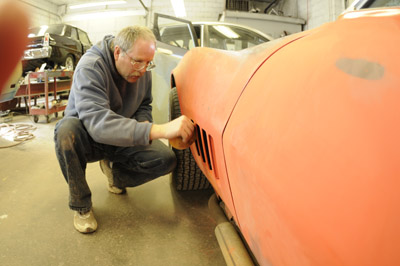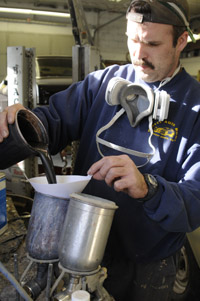Source: Jerry F. Boone, Oregonian Drive Time, March 7, 2009

Mark O’Dell runs his finger over the side louvers in the 1969 Corvette’s bodywork, feeling the fiberglass surface for the tiniest flaw.
He wants this car to look right. It’s his.
“But I also want it to be something I can drive, something that isn’t so expensive that I’m afraid to take it out on the road,” O’Dell, 50, says. So he’s adding chrome to the engine and making tweaks to both the performance and appearance.
“It’s my car, so I want it to be what I want, not what someone tells me is ‘right’ for it,” he says.
That philosophy is a reflection of how he does business.
Working from a two-man specialty shop a few blocks off Forest Grove’s main street, O’Dell Auto Body & Paint is building a reputation for creating cars that look good both on the street and on the display stand.
“I used to do ‘trailer queens’ that never got their tires dirty,” he explains between gentle swipes with a slice of fine sandpaper, “but it is a lot more rewarding to work with guys who want to drive their dreams.”
O’Dell began his career in the high-end restoration business, but gradually shifted from doing specialty work to the bread-and-butter collision jobs that keeps auto body shops open. He worked with a couple new car dealers in Hillsboro, until dealership mergers and sales left him without a place to operate.
“I went from having lots of room and lots of work and lots of employees to being half of a two-man shop where we enjoy coming to work and take a lot of pride in what we create.”
He can squeeze about five cars in the shop. Currently it holds O’Dell’s Corvette, a 1969 Plymouth Roadrunner undergoing restoration and a gleaming, black 1967 Chevy II fitted with a big-block V-8.
The Chevy is Ed Johnston’s dream car.
“The first car I ever owned was a Chevy II,” says the Gaston enthusiast. “This one’s a lot better.”
Johnston says he and O’Dell went over every bit of the car and agreed on what would be done and for how much, before any work was begun.
“Mark was up-front about the quality of work they do,” Johnston says. “I wanted something I could be proud to drive, but it didn’t have to be a show winner. I didn’t need that.”
O’Dell says the difference between one of his cruise-in cars and a concours-winning car is simply time and money.
“They each take the same number of parts,” he says, “but the cost goes up every time we have to sand and prime and sand and prime. A concours judge can see the difference, but most enthusiasts can’t. And that’s who is paying the bill.
“We can do a concours-winning car, but the folks we work with generally don’t want to spend that kind of money,” O’Dell says.
Once in a while he turns a job down.
“Folks want us to tackle a car that is just so bad that there is no way it could be done for a reasonable price, and the cost would be way out of proportion to what the owner ends up with.”
On the Chevy II, Johnston and O’Dell worked together on ways to shave the bill and keep the project affordable. The bill on Johnston’s was under $7,000.
“There was some of the work like the interior and the trim that’s pretty time consuming and expensive for them to do, but that I could do myself and save a bunch of money,” Johnston says. “When they got the car, it was completely gutted except for one seat.”
Unlike some restoration shops where a car disappears behind a garage door and emerges two years later with a jaw-dropping bill, O’Dell insists each owner stays involved in the project.
“If I didn’t drop by almost every week, he’d call me with updates,” Johnston says. “I know exactly how much things cost and where the money was being spent.”
On occasion that owner involvement can backfire, says Jon Maslen, O’Dell’s only employee and the shop painter.

“We painted the engine bay of the Road Runner the exact color the owner picked out,” Maslen explains, “but when he came by to check on progress, it wasn’t the color he wanted. He and I played for a long time mixing colors until we got what looked right to him.
“But for us it was important that it be what he wants,” he says.
In Johnston’s case, the color he wanted was a bit different than most.
“I carried around this bottle of black cherry soda, because that’s the color I wanted the car to be,” he says. “Mark finally sent me directly to the paint shop, and they let me take color chip books home over a weekend so my wife and I could come up with the right mix.”
Apparently, it was an excellent choice.
Shortly after picking up the car from O’Dell’s, Johnston entered the Chevy II in the prestigious Wapato Showdown, an annual gathering of Oregon cars that compete against one another in an open class.
His finished second out of more than 400 entries.
“Not bad for a car that Mark says wasn’t built to win shows,” he says. “For the money, it is more car than I ever dreamed of having.”